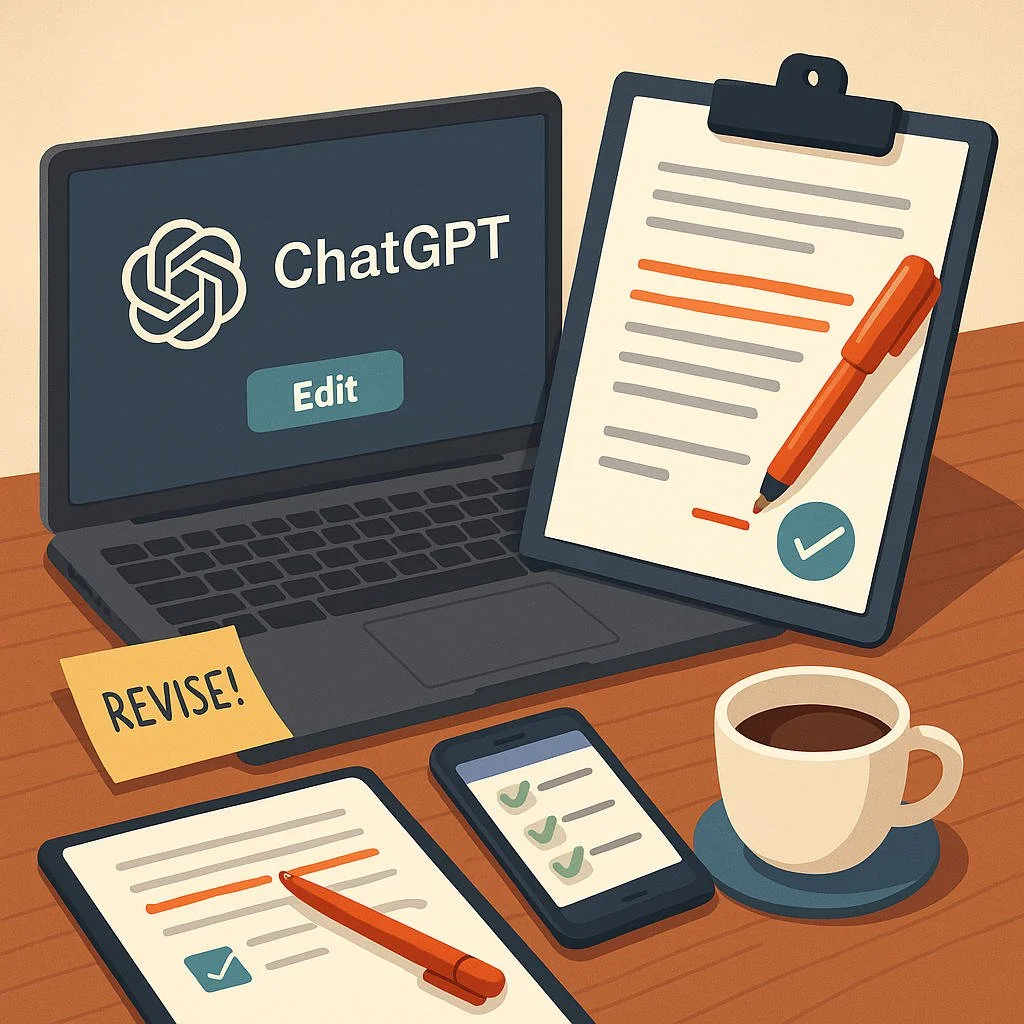How to Use ChatGPT to Edit a Document
Great editing isn’t “make it sound better.” It’s a repeatable process that protects your intent and voice while improving clarity, structure, accuracy, and polish. Treat ChatGPT as a multi-tool editor:
Define the brief and level of edit.
Protect voice, facts, and constraints.
Edit in stages (structure → clarity → style → surface).
Audit for accuracy, bias, and compliance.
Package the output for your workflow (Word, Google Docs, CMS).
Everything below is practical, with prompts you can paste.
Step 1 — Decide the level of edit you actually need
Editing has layers. Ask for the right one:
Developmental edit (content/structure): goals, audience, flow, what’s missing, what to cut or reorder.
Line edit (style/voice): sentence rhythm, word choice, transitions, tone cohesion.
Copyedit (mechanics): grammar, punctuation, usage, consistency with a style guide.
Proofread (surface): typos, spacing, broken lists, final formatting.
Fact check (accuracy): names, numbers, timelines, citations.
Sensitivity & bias check (ethics): loaded language, stereotypes, accessibility.
Prompt: Edit Scope Selector
“Act as a managing editor. Read this [type of doc] for [audience]. My priority is [clarity / persuasion / brevity / polish]. Recommend the level(s) of edit I need and why. Then outline a step-by-step plan.”
Step 2 — Lock your voice and constraints before changing a word
Protect what must not change.
Create a Voice Card
Purpose and audience
Tone adjectives (e.g., warm, plain-spoken, authoritative)
Sentence length target and jargon rules
Examples of on-voice and off-voice lines
Forbidden phrases, legal disclaimers, SEO terms (if applicable)
Prompt: Voice Card Builder
“Extract a voice profile from this sample [paste 2–3 paragraphs you like]. Output tone adjectives, sentence cadence, vocabulary tendencies, and 4 ‘do/don’t’ rules. I’ll use this to constrain edits.”
Prompt: Guardrails
“When editing the following, obey this Voice Card [paste]. Do not invent facts. Do not alter claims without flagging them. Keep proper nouns and numbers as-is unless contradicted internally.”
Step 3 — Structural pass (developmental editing)
Fix the map before the road surface.
What to look for
A clear thesis and promise in the opening
Logical section order and smooth transitions
Redundant or off-topic sections
Missing pieces the audience expects
Calls to action and next steps
Prompt: Structure Surgeon
“Analyze structure only. Summarize the doc’s thesis in 1–2 lines, list sections with one-line purpose each, and propose a revised outline that improves flow. Identify cuts, merges, and new sections the audience would expect.”
Prompt: Section Rewrite Plan
“For each section in this outline [paste], give me: (1) goal, (2) 3 talking points, (3) a transitional sentence from the prior section.”
Step 4 — Clarity pass (line editing for meaning)
Make every sentence earn its keep.
Clarity tactics
One idea per sentence
Prefer concrete nouns and strong verbs
Turn buried verbs (“make a decision”) into verbs (“decide”)
Front-load context, end with impact
Break long sentences at 25–30 words unless rhythm demands longer
Prompt: Clarity Rewrite (Respect Voice)
“Rewrite this section for clarity and concision while preserving meaning and the Voice Card. Keep examples, numbers, and legal phrasing intact. Return a side-by-side: ‘Original’ vs ‘Revised’ with 1-line rationale per change.”
Prompt: Over-Explainer Mode
“Find sentences that assume knowledge. Add one clause of necessary context in brackets after each, without bloating the paragraph.”
Step 5 — Style pass (tone, rhythm, transitions)
Now make it read like one mind wrote it.
Style checklist
Consistent person (I/we/you) and tense
Transitional glue between paragraphs
Parallelism in lists (“Start with…”, “Then…”, “Finally…”)
Controlled repetition for emphasis
Varied sentence lengths for pace
Prompt: Style Harmonizer
“Smooth tone and rhythm to match the Voice Card. Add transitions where jumps occur. Highlight any repeated metaphors or clichés and replace with fresher alternatives (same meaning).”
Step 6 — Copyedit pass (mechanics & consistency)
Clean up the micro-stuff—consistently.
Pick a style guide (e.g., APA, Chicago, AP, company style) and a dictionary. Note regional spelling (US/UK/Canada).
What to enforce
Capitalization, hyphenation, numerals, date/time formats
Oxford comma policy, list punctuation
Terminology glossary (product names, acronyms)
Figure/table/appendix references
Prompt: Style-Guide Enforcer
“Copyedit for [style guide] and [region] spelling. Create a style sheet as you go listing decisions (capitalization, hyphenation, numerals, dates). Apply consistently across the doc.”
Step 7 — Fact check & citation sanity
Don’t let polish hide wrong info.
What to verify
Names, titles, organizations
Numbers (totals, percentages, units)
Dates and timelines
Quotes and attributions
References match the in-text claims
Prompt: Fact-Check Matrix
“Extract all verifiable claims (names, numbers, dates) into a checklist. For each, show the exact sentence, what needs verifying, and a placeholder note for the source I must confirm. Do not invent sources.”
Prompt: Citation Consistency
“Scan references and in-text mentions for mismatches, missing years, broken numbering, and duplicate entries. Output fixes I can apply.”
Step 8 — Sensitivity, bias, and accessibility checks
Make the doc safe and inclusive.
What to check
Biased or coded words
Unnecessary demographic details
Reading level (aim to match audience; many public docs target ~Grade 8–10)
Headings hierarchy and descriptive link text
Alt-text notes for images (if any)
Prompt: Sensitivity & Accessibility Review
“Flag biased or exclusionary terms and offer neutral alternatives. Estimate reading level and suggest edits to reach [target grade] without oversimplifying key terms. Add alt-text placeholders for any images referenced.”
Step 9 — Surface pass (proofread)
Catch the last sand grains.
Proofread checklist
Typos and doubled words
Spacing, punctuation around quotes and dashes
Numbered/bulleted list alignment
Heading capitalization style
Orphan headings/single-line paragraphs
Widows/orphans (if laying out for print/PDF)
Prompt: Proof Pass
“Proofread for surface errors only. List corrections as ‘Find → Replace’ with line numbers or unique snippets so I can locate them quickly. Do not rewrite for style in this pass.”
Step 10 — Packaging and version control
Make handoff painless.
Best practices
Name versions with date + stage (e.g.,
DocName_v3_LineEdit_2025-11-10).Keep a change log: what changed and why.
Deliver both clean copy and redline (or side-by-side) when stakeholders review.
Store a voice card and style sheet alongside the document.
Prompt: Handoff Kit
“Create a change log summarizing major edits (structure, clarity, style, copy), plus a final Voice Card and Style Sheet. Provide instructions for importing into [Word/Google Docs/CMS] and preserving formatting.”
Special cases & tailored prompts
Academic papers
Maintain formal tone, cautious claims, and precise citations.
Guard against accidental patchwriting.
Prompt:
“Edit for academic tone and precision. Convert informal phrasing (‘proves’) to cautious language (‘suggests’). Preserve all citations; flag any paragraph that paraphrases too closely to a known source.”
Legal and policy
Accuracy and defined terms trump clever phrasing.
Prompt:
“Edit for legal clarity. Expand defined terms on first use, retain capitalization, and avoid ambiguous pronouns. Flag any sentence where obligations or rights could be misread.”
Technical docs & APIs
Priority: correctness, reproducibility, and unambiguous steps.
Prompt:
“Edit this API guide for precision. Ensure parameter names match exactly, code blocks compile, and steps are numbered with expected outputs. Add pre-reqs and failure modes.”
Marketing & sales
Emphasis on benefits, objections, and CTA clarity.
Prompt:
“Tighten for conversion. Surface the core benefit in the first 2 sentences, add a skimmable list of outcomes, anticipate one objection with a one-line rebuttal, and end with a concrete CTA.”
UX microcopy
Short, specific, reassuring.
Prompt:
“Rewrite for UX microcopy. Max 7–12 words per line. Use action verbs, speak to the user (‘you’), avoid blame, and provide one recovery step for errors.”
Collaboration tips (Google Docs / Word / CMS)
Chunk edits: ask ChatGPT to return section-by-section so you can paste incrementally.
Comment mode: request suggested changes as comments when stakeholders want control.
Track changes emulation: ask for
~~deleted~~and bold inserts if your CMS lacks track changes.Snippet IDs: include small, unique identifiers in comments so you can find lines quickly.
Prompt: Comment-Only Mode
“Review this section in comment-only mode. Quote the original snippet, suggest the replacement in bold, and give a one-line reason. Do not rewrite the entire paragraph unless requested.”
Quality bars (how to know it’s ready)
The opening makes a clear promise and the ending delivers it.
Each section has a job, and the order flows logically.
Sentences are clear, varied, and free of filler.
Facts, names, and numbers are verified or flagged.
Tone is consistent with the Voice Card.
No unresolved comments, placeholders, or TODOs.
A clean export exists in the target format.
Copy-and-paste prompt kit (quick access)
1) Scope & Plan
“I’m editing a [type] for [audience]. Primary goal: [clarity/persuasion/polish]. Recommend the level(s) of edit and a step-by-step plan.”
2) Voice Card
“From this sample [paste], produce a Voice Card: tone adjectives, sentence cadence, vocabulary, and 4 do/don’t rules.”
3) Structure
“Outline the document’s current structure and propose a better one. Identify cuts, merges, and missing sections.”
4) Clarity
“Rewrite for clarity and brevity while preserving meaning and numbers. Return side-by-side lines with reasons.”
5) Style
“Harmonize tone and rhythm to match the Voice Card. Add transitions and remove clichés.”
6) Copyedit
“Apply [style guide] and [region] spelling. Build a style sheet of decisions.”
7) Fact-check
“Extract verifiable claims into a checklist with sentence, item to verify, and a ‘source needed’ note.”
8) Sensitivity/Accessibility
“Flag biased terms, simplify to [grade level], and insert alt-text placeholders.”
9) Proofread
“List surface fixes as ‘Find → Replace’ with location hints. No stylistic rewrites.”
10) Handoff
“Create a change log and final Voice Card/Style Sheet. Provide import/export instructions for [tool].”
Checklists (print these)
Pre-edit setup
Voice Card created
Style guide & region chosen
Goals and audience defined
Constraints listed (legal, SEO keywords, length, deadlines)
Editing passes
Structure improved (thesis, order, transitions)
Clarity tightened (one idea/sentence, strong verbs)
Style harmonized (tone, rhythm, parallelism)
Copyedited (mechanics consistent, style sheet made)
Facts checked (names, numbers, dates)
Sensitivity & accessibility reviewed
Proofread (typos, spacing, list formatting)
Packaging
Clean & redline versions exported
Change log written
File named with version/date
Voice Card + Style Sheet included
Troubleshooting (common pain points)
“It sounds generic/AI-ish.”
Feed a stronger Voice Card with your sample paragraphs. Ask for “minimal-change edits” in the prompt.
“Stakeholders keep undoing edits.”
Return side-by-side with brief rationales and keep high-impact edits separate from cosmetic ones.
“We disagree about tone.”
Provide three tone variants (formal/neutral/warm) on the same paragraph and let stakeholders pick.
“Facts changed during editing.”
Lock facts with [DO NOT ALTER] tags around sensitive sentences; ask for flags instead of rewrites.
“The doc got longer.”
Set a hard word target and ask for a “Keep/Cut/Merge” table before rewriting.
One-hour sprint (from messy draft to publishable)
0–10 min: Build Voice Card + pick style guide.
10–20 min: Structure Surgeon → confirm outline.
20–35 min: Clarity pass on the top 3 sections.
35–45 min: Style harmonizer + transitions.
45–55 min: Copyedit + quick fact-check checklist.
55–60 min: Proof pass + export clean/redline + change log.
TL;DR (finally)
Start with a Voice Card and explicit edit scope.
Edit in passes: structure → clarity → style → copyedit → fact check → proof.
Use targeted prompts (side-by-side diffs, comment-only mode) to keep control.
Produce a style sheet and change log; export clean and redline versions.
When the opening makes a promise, the order flows, the tone is consistent, and every fact is either verified or flagged—you’re done.







